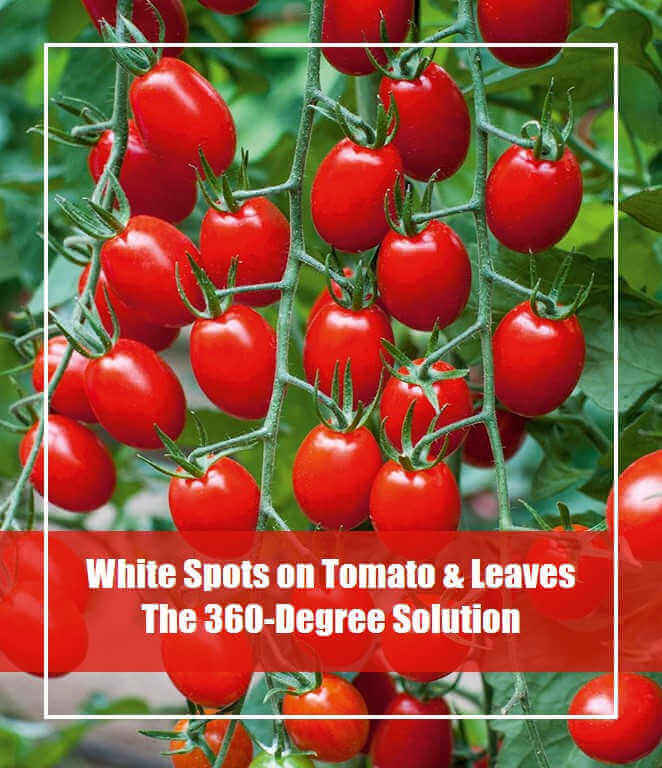Tomato is a popular vegetable among the gardeners. But the bad news is that it is the only crops that can be damaged very fast by the pest and diseases. You know there are many diseases of tomato. And white spots on tomato one of these.
White spots on tomato can be a sign of diseases, insect infestation, or nutrient deficiency. You have to diagnose before treatment. But Be careful. our wrong decision can kill the plants!
In this article, I have tried to identify what reason behind the white spots on tomato skin or leaves and what steps you should take to control it.
Causes and Controlling Measure of White Spots on Tomato
You may notice white spots on the skin or inside the skin of the tomato. But don’t mix up them! You have to consider them differently to treat your tomato. White spots on the skin and inside the skin are a totally different problem and both have an individual causal agent.
5 Causes of White Spots on the Skin of Tomato
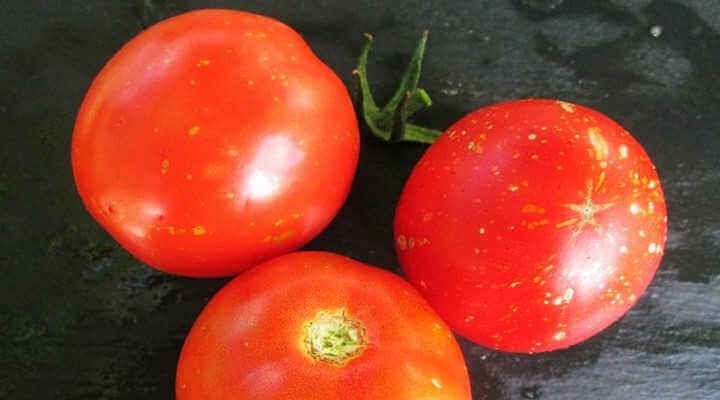
1# Cloudy Spot/Stink Bug Damage
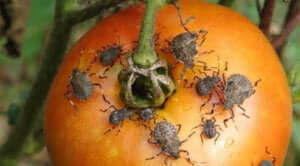
Stink bug or brown marmorated stink bug is the most destructive insect for tomato. Stink bug sucks the fruit sap and injects toxic saliva. As a result, the water content of tomato fruits increases, and white, yellow, light green spots or patches appear on the tomato skin. Toxic saliva kills the bunch of cells and reduces the quality and flavor of the fruits. That is also called a cloudy spot of tomato.
To control cloudy spot of tomato-
Pick off the affected fruits. Spray hot water and organic insecticide for tomatoes like neem oil or insecticidal soap (Keep reading to know how to use these and other natural insecticides).
2# Others Insect Feeding
Besides Stink bugs, other insects (e.g. aphids, thrips, beetles, whiteflies, spider mites, leafhoppers, bugs, and leaf-footed bugs) can be the cause of white spots under the skin of the tomato. They insert their needle-like mouthparts into the developing green or ripening fruit to feed the fruit sap and inject the saliva toxin.
The nibbled area stops developing and appears white hallow. Though the symptoms exist in the green or developing stage, it mainly appears on ripe fruits.
To get rid of insects from tomato-
Neem Oil
Neem oil is a versatile product for the organic gardener. It can be used as insecticide, fungicide, or pesticide.
Mix 3 tablespoons of neem oil with 1 gallon of water, wait for 1 week, and spray the plants to get rid of insects. Here is the recommended neem oil for your tomato plants- Bonide (BND022) – Ready to Use Neem Oil
Insecticidal Soap
Another mostly used organic insect repellant is insecticidal soap. It is also known as horticultural soap.
Mix 5 tablespoons of liquid soap with 1 gallon of water and add a teaspoon of vegetable oil to make soap spray. Now pour the solution into a sprayer and spray it on the tomato plants.
You can pick readily available insecticidal soap which is more effective-
- Safer Brand 5118 Insect Killing Soap: Mix 4 tablespoons of liquid insecticidal soap with 1 quart of water and apply.
- Natria 706230A Insecticidal Soap: Shake the solution and apply. No need to add extra water.
Garlic Spray
Garlic spray is an eco-friendly insect repellent. It can be the quick home solution to get rid of insects.
To make garlic spray-
Take and chop 15-20 cloves. Pour them into 1-liter water and start boiling the water for 20 minutes. Let them be cool and filter the solution. Lastly add few drops of dishwashing soap and spray the plants. You can also use the garlic paste to make the garlic spray.
You may also purchase the ready-made garlic spray from the horticulture shop or amazon. Here is the recommended garlic spray for your tomato–
- Garlic Barrier 2002 AG+ Liquid Spray: Mix with water and spray on the plants.
Insect repellent plants
Insect hates some plants. You can make a barrier by these plants to repel insects from tomato plants. There are many plants to repel the insect such as Marigolds, Chrysanthemums, Citronella grass, Lavender. Different plants hate different plants (Read more – Natural Garden Pest Control Guide)
3# White Fungus
The white fungus can develop if the plant can’t get enough light and air. If you notice white powdery substances on the tomato, then it may be the cause of fungus called powdery mildew.
To treat the tomato
Pick off the affected fruits and mix 1 teaspoon of baking soda, vegetable oil, and liquid dish soap with 1 liter of water. Shake it well and spray.
Neem oil can also be effective to get rid of the fungus as well as an insect.
4# Bacterial Canker of Tomato
Clavibacter michiganensis subsp. michiganensis (Cmm) is the pathogen of bacterial canker of tomato. Warm temperature and high humidity increase the infestation. Small, creamy, whitish halo or bird eye spots (brown center spots) appears on ripe tomato.
If the spots are black, then it will bacterial specks of tomato. Don’t think white and black spots are the same.
To control Bacterial canker of tomato-
Remove the affected plants or fruits by handpicking and apply liquid copper fungicide spray for tomato (Our pick: Southern Ag – Liquid Copper Fungicide) or Bordeaux mixture. Don’t use any hand equipment. It can be spread through tools.
Crop rotation and seed treatment can prevent bacterial canker.
To treat the seed-
Soak the tomato seed into 120°F water for 25 minutes.
Now comes the question about the affected tomatoes that is it safe to eat tomatoes with bacterial canker?
Yes! You can. CMM doesn’t harm to a human or animal.
5# Sunscald of Tomato
Sunscald can be the reason for white spots on your tomato. Sunscald occurs if the green tomato gets too much sun. Because of sunscald of tomato, white, gray, and papery spots appear on the side of the fruit that faces the sun. The spotty areas don’t ripen.
How do you treat Sunscald on tomatoes?
You can treat by limiting the pruning of tomato. Add 1-inch mulch and use shade cloth to provide extra shade during hot and sunny days.
Causes of White Spots Inside the skin of Tomato
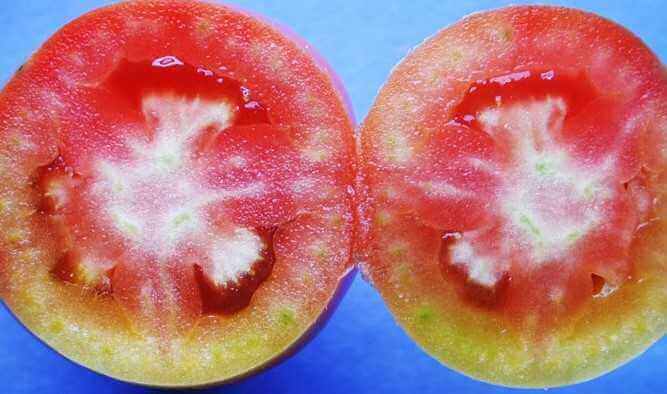
Hard white spots or patches inside the tomato are the sign of uneven ripening. Deficiency of nutrition, higher temperature, and disease may cause the white spots inside the skin of the tomato.
To control white spots inside the tomato-
Use tomato fertilizer with less Nitrogen and more Potassium at the time of fruit get larger than a quarter. Potassium is a water-soluble fertilizer. That’s why it leach out with water and decrease the required potassium level. Add greensand organic soil conditioner to prevent leaching out of potassium. It has others benefit too.
Recommended greensand soil conditioner- Espoma GS7 Greensand Soil.
# Yellow Shoulder and Blossom End Rot (BER)
Whitish, yellowish discolor region appears under the skin of the tomato. It reduces the quality and taste of the tomato. Adverse weather conditions, soil with low potassium, low organic matter and high soil pH may be the cause of BER of tomato.
To control BER-
Soil pH between 6.0 and 6.8 and higher potassium can control BER.
Additions Information You Should Know
The reasons for not ripening the tomato-
- Higher Temperature: Below 60 degrees and above 90 degrees.
- Compact and hard soil.
- Overly wet soil: It inhibits the root system of the tomato plant which restricts the fruit ripening.
- Low potassium level: It stunts fruit development and maturity. It can also reduce the absorption of Calcium and Magnesium that essential for fruit maturity.
The reasons for uneven or blotchy ripening of tomato-
- Temperature below 60 degrees.
- Compact soil and hard soil.
- Viral diseases.
- Heavy infestation of whiteflies
- Yellow shoulder and Blossom end rot (BER).
Is It Safe to Eat Tomatoes with White Spots?
Cut out the white portion of the tomato and eat the rest of the fruits. It should be fine to eat. Stink bug pathogen and CMM don’t harm to the human and animal. But the taste may be different from normal tomatoes.
Causes and Controlling Measures of White Spots on Tomato Leaves
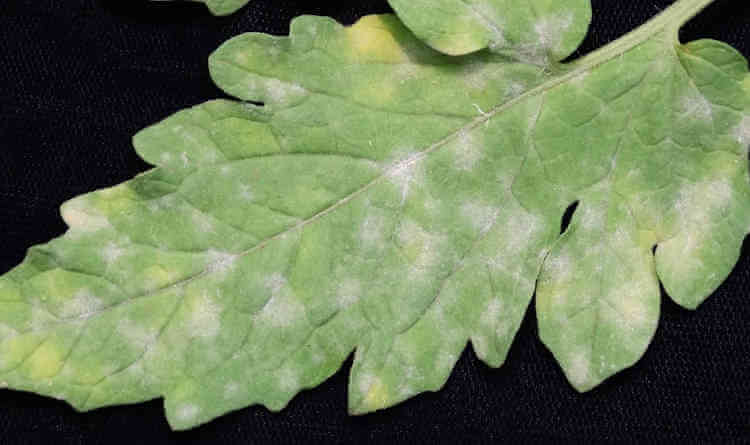
#Insect and Pest Feeding
Insects and pests may be the cause of white spots on tomato plant leaves as well as tomato fruits. The aphids, whiteflies, thrips, bugs, and ants(Here is the guide on getting rid of ants on tomatoes) are the major insect for tomatoes.
Tomato has soft and juicy leaves. Insects love to absorb the sap that remains in the leaves. So tiny white spots appear on the tomato leaves as the sign of insect and pest feeding.
The insect can cause more damage to your tomato seedling leaves. So control insect and pest and get rid of it.
#Powdery Mildew
The white spots on leaves and stems are most likely to be powdery mildew. It is one of the most problems of nightshade plants like a tomato. The fungus is the main cause of the disease. Powdery mildew develops in hot and humid or cold weather.
You can apply Chlorothalonil based fungicide to control powdery mildew of tomato. Others Organic Control measures of powdery mildew-
Neem Oil
Neem oil is an effective fungicide. It can kill fungus within a day. We can use this organic oil to treat the tomato plant. Personally I would like to apply neem oil if my tomato plant appears white spots on the leaves.
Insecticidal Soap
Soap has long-chain potassium-based fatty acid that helps create an unfavorable condition for growing fungus. Besides, it is less harmful in comparison to other chemical fungicides.
Baking Soda and Vegetable oil
Baking soda has a pH of 8.3. So applying baking soda creates alkaline whether that kills the fungus. Vegetable oil accelerates this killing process.
Mix 1 teaspoon of baking soda, 1 tablespoon of vegetable oil with 1 liter of water. Shake it well and spray it on the affected plants.
Recommended baking soda and vegetable oil that you can pick-
Potassium Bicarbonate
Potassium Bicarbonate is the most recommended method to get rid of powdery mildew. It also creates alkaline weather to kill the fungus.
Mix 3 tablespoons potassium bicarbonate (Our pick: Potassium Bicarbonate 2 oz), 3 tablespoons vegetable oil, and ½ tablespoon liquid dish soap with 1-gallon water. Shake the solution and spray it on the plants in the evening.
Vinegar
Mix 4 tablespoons of white vinegar with 1 gallon of water and spray on the plant’s leaves.
Milk
Mix 400 ml milk with 600 ml of water. Pour the solution in a spray bottle and spray on the affected plants
Copper Fungicides
It is the quickest method to get rid of powdery mildew of tomato leaves. Pick the best copper fungicides (Our pick: BONIDE Ready-to-Use Copper Fungicide). Read the instruction label and apply it to control the mold spot of tomato leaves.
#Adverse weather and Cultural problems
Adverse weather and cultural problems may be the causes of white spots on tomato plants. Extra sun or extra shade helps to develop fungus on the leaves.
Provide shade and proper pruning the plants can help to prevent the small white spots.
Lack of nitrogen, sulfur, calcium, or magnesium may be the cause of white or yellowish leaves of tomato. Apply 10-10-10 or 8-8-8 fertilizer(Our pick: Southern Ag All Purpose Granular Fertilizer)
Cautions: At first, apply these solutions and fungicides on the small portion of the tomato leaf. Mix more water if you notice the plant leaves burn and must spray water before applying the solution and repeat the treatment every 10 to 14 days if required.
Conclusion
I hope you have got the solution to control and prevent white spots on tomato and leaves. You know I have tried to discuss every possible reason with the solutions. Thereafter If I miss anything that you know. Don’t forget to share your knowledge in the comment section below. Your gardening experiences can help others.
Happy Gardening!

